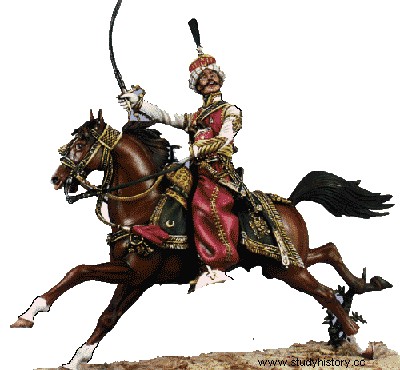
This term designates, in Arabic, white slaves.
From 1250 to 1517, these slaves, mostly of Turkish origin, ruled Egypt. When the Ottoman sultan installed a pasha in Egypt, the latter kept the Mamluks as provincial administrators with the title of bey. Since 1770, the 24 beys hold almost all the power, the pasha having hardly any authority. It is their army that Bonaparte must face to conquer Egypt.
On September 7, 1798, the winner decided to enroll young Mamluks aged eight to sixteen in the French army. The mix proving to be difficult, we were content to form a company of Mamluk horsemen with uniforms and weapons inspired by the East. In 1799, Bonaparte brought back with him Roustam and Raza. But there were also a hundred other Mamluks who landed with the Army of the East in Marseilles in 1801. They were gathered into a squadron under the command of Rapp and reunited in 1804 with the regiment of mounted chasseurs of the imperial guard ..
Their reputation for courage was soon established on the battlefields and they were only 18 survivors at the fall of the Empire. As for the Mamluks of Egypt, the pasha Mehemet-Ali had their leaders massacred in 1811 and definitively broke their power.
When Bonaparte arrived in Egypt, a warrior oligarchy reigned despotically over this country. On his return to France, the young general-in-chief organized a company of some deserters from Ibrahim and Murad Bey to whom he had added a skewer of Georgians, Armenians and Circassians who were fleeing slavery. But these fifty horsemen in variegated tinsel made a splendid escort to the future conqueror. During the organization of the Imperial Guard in July 1804, Napoleon decreed that the company of Mamluks would be attached to the regiment of chasseurs à cheval.
It would have a French staff and be 124 strong.
This number fell to 102 from 1806 to 1810, then rose again to 250 men in January 1813, when the company was converted into a squadron. It goes without saying that all the Mamluks were no longer pure sons of the Orient; at their dismissal in 1814, the real Mamluks were only eighteen. They were almost all massacred by the mob on joining their families in Marseilles.
Roustan, Napoleon's famous Mamluk, who had been showered with favors by his master, abandoned him and refused to follow him to the island of Elba, exhibited himself in London and died in obscurity at Dourdan, at the age of sixty-five years. Contrary to popular belief, this man, who was almost as famous as his master, was never a Mamluk of the Guard!
The headdress of the Mameluks was the tarbouch, a kind of flat chechia, replaced in 1807 by the taller cahouk; both wrapped in the shal or turban. A loose dress, the beniche, of various colors, was worn under the yalek or waistcoat, the trousers - charroual - were most often crimson, amaranth or scarlet red. Finally, the boots or khouffs were red, green or yellow.
The horses were those of mounted hunters and not Arabian horses.
